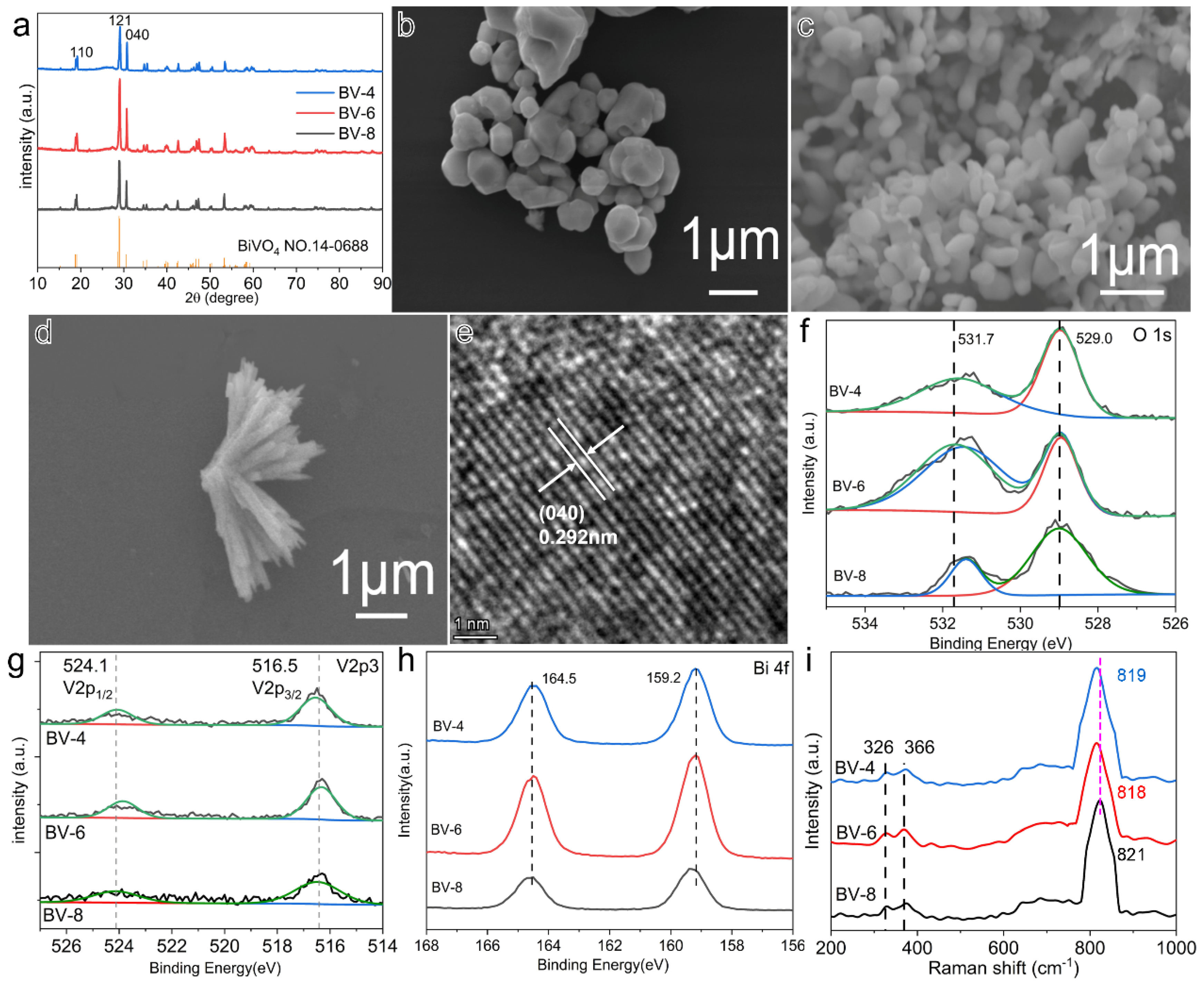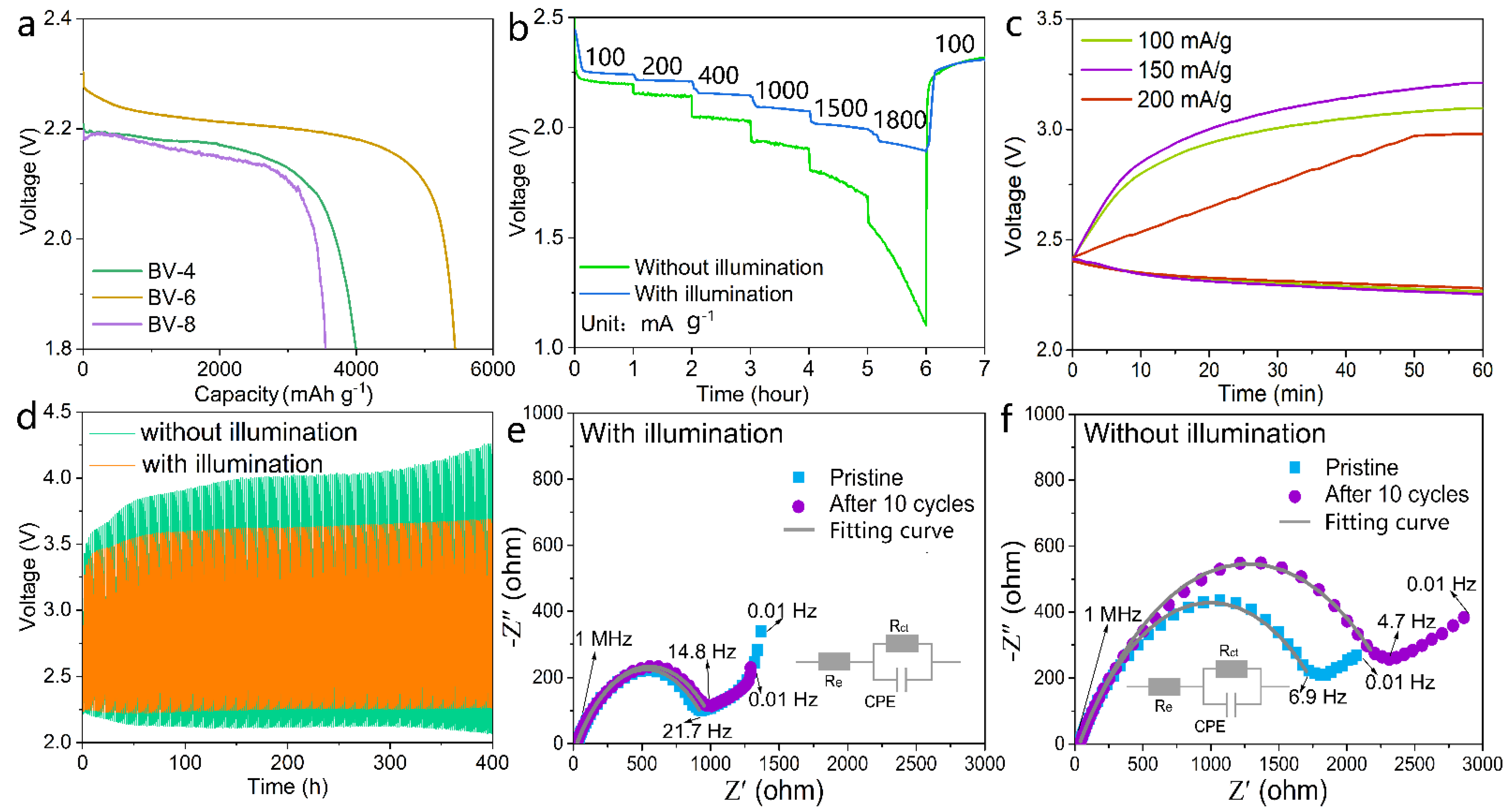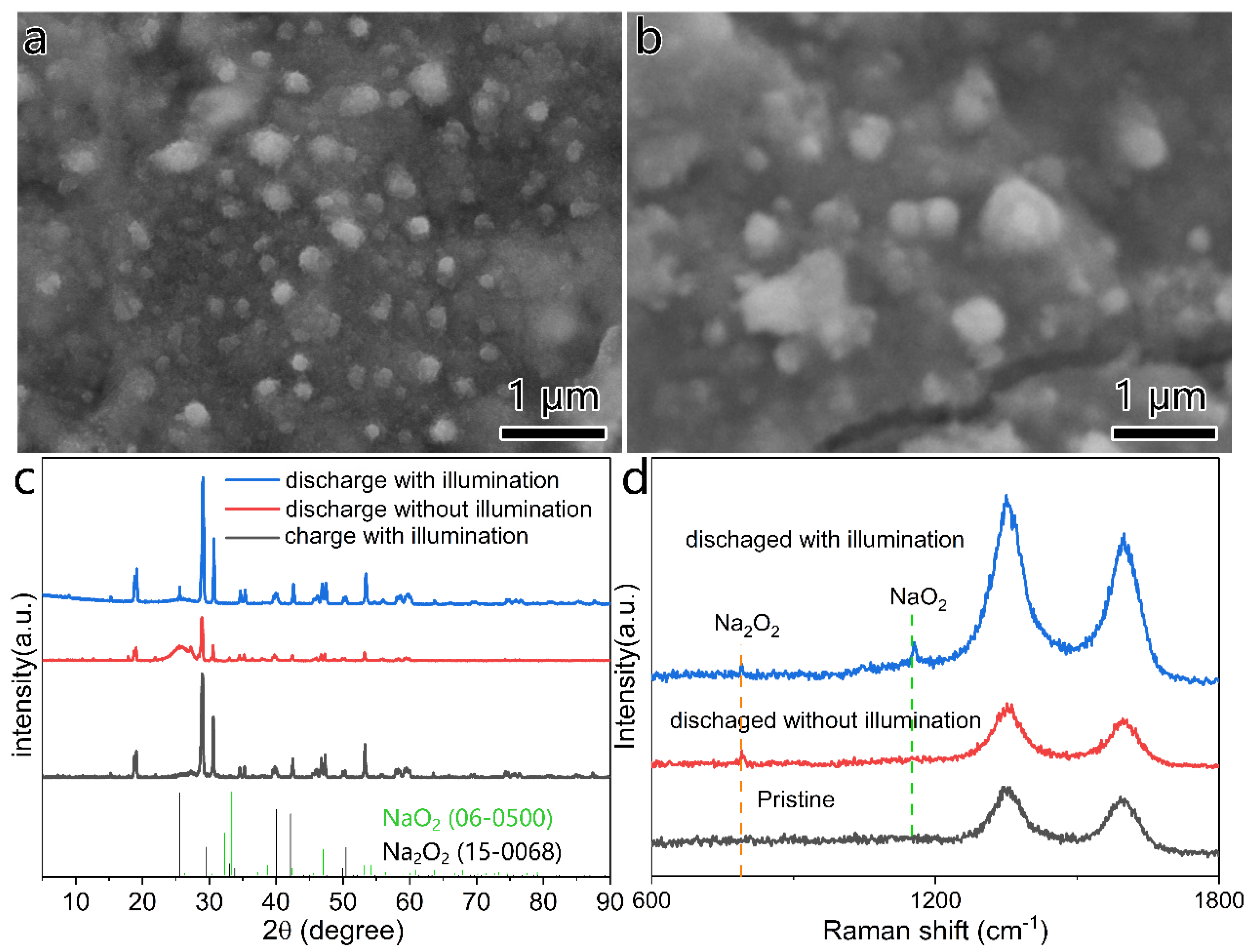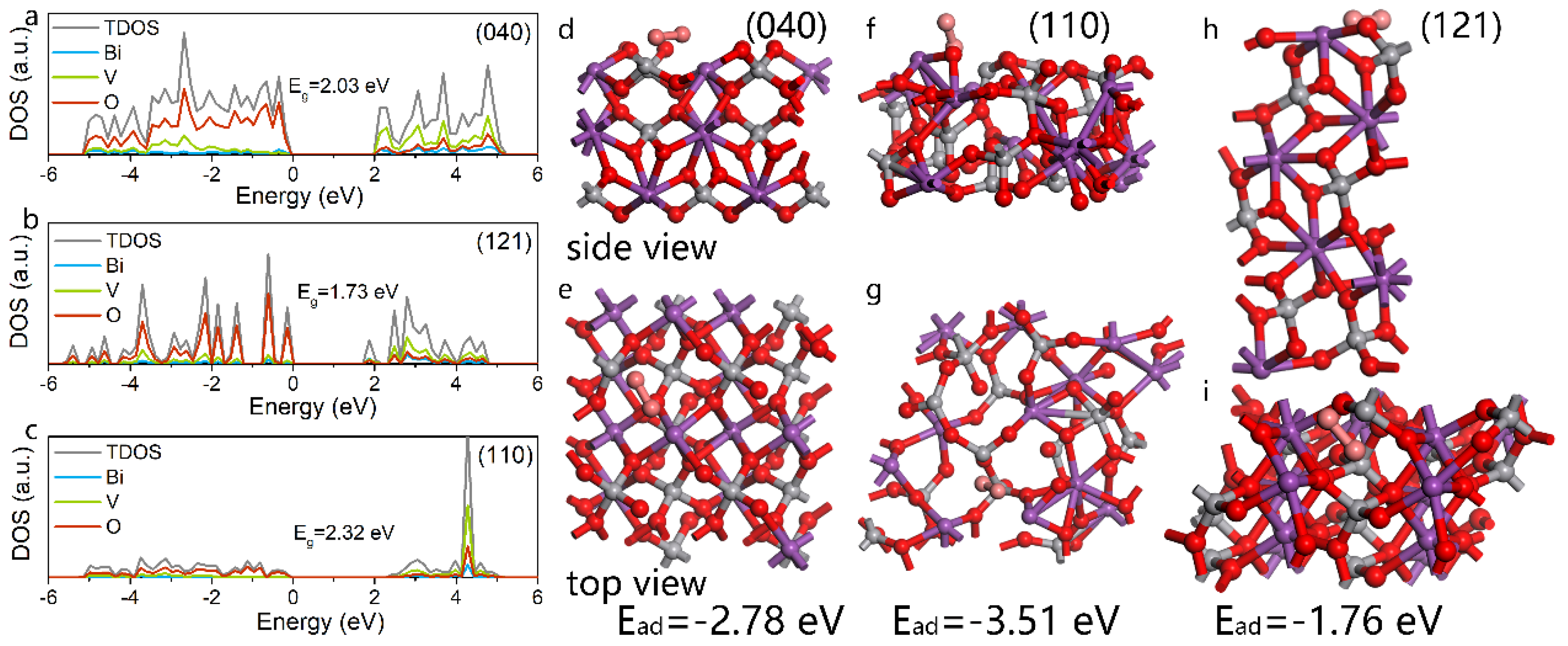A Solid Redox Mediator Analog as a Highly Efficient Catalyst for Na–O2 Batteries
Abstract
:1. Introduction
2. Materials and Methods
2.1. Bismuth Vanadate Preparation
2.2. The Electrode Preparation
2.3. The Assembly of Na–O2 Batteries
2.4. Characterization
2.5. Electrochemical and Photoelectrochemical Measurement of Na–O2 Batteries
2.6. Computational Methods
3. Results
4. Conclusions
Supplementary Materials
Author Contributions
Funding
Data Availability Statement
Acknowledgments
Conflicts of Interest
References
- Fang, R.; Chen, K.; Yin, L.; Sun, Z.; Li, F.; Cheng, H.-M. The Regulating Role of Carbon Nanotubes and Graphene in Lithium-Ion and Lithium-Sulfur Batteries. Adv. Mater. 2019, 31, 1800863. [Google Scholar] [CrossRef] [PubMed]
- Zhang, C.; Shen, L.; Shen, J.; Liu, F.; Chen, G.; Tao, R.; Ma, S.; Peng, Y.; Lu, Y. Anion-Sorbent Composite Separators for High-Rate Lithium-Ion Batteries. Adv. Mater. 2019, 31, 1808338. [Google Scholar] [CrossRef] [PubMed]
- Reddy, M.V.; Mauger, A.; Julien, C.M.; Paolella, A.; Zaghib, K. Brief History of Early Lithium-Battery Development. Materials 2020, 13, 1884. [Google Scholar] [CrossRef] [PubMed] [Green Version]
- Yu, C.; Ganapathy, S.; Van Eck, E.R.H.; Wang, H.; Basak, S.; Li, Z.; Wagemaker, M. Accessing the bottleneck in all-solid state batteries, lithium-ion transport over the solid-electrolyte-electrode interface. Nat. Commun. 2017, 8, 1086. [Google Scholar] [CrossRef] [PubMed] [Green Version]
- Zheng, Z.; Wu, C.; Gu, Q.; Konstantinov, K.; Wang, J. Research Progress and Future Perspectives on Rechargeable Na-O2 and Na-CO2 Batteries. Energy Environ. Mater. 2021, 4, 158–177. [Google Scholar] [CrossRef]
- Benti, N.E.; Gurmesa, G.S.; Geffe, C.A.; Mohammed, A.M.; Tiruye, G.A.; Mekonnen, Y.S. Sodium-ion diffusion studies of the cathode-electrolyte interfaces (NaxO2@Na2CO3, x = 1 and 2) and discharge products of non-aqueous rechargeable sodium-air batteries. J. Mater. Chem. A 2022, 10, 8501–8514. [Google Scholar] [CrossRef]
- Kang, Y.; Wang, S.; Zhu, S.; Gao, H.; Hui, K.S.; Yuan, C.-Z.; Yin, H.; Bin, F.; Wu, X.-L.; Mai, W.; et al. Iron-modulated nickel cobalt phosphide embedded in carbon to boost power density of hybrid sodium-air battery. Appl. Catal. B-Environ. 2021, 285, 119786. [Google Scholar] [CrossRef]
- Kim, S.; Jung, Y.; Park, J.; Hong, M.; Byon, H.R. Sodium fluoride-rich solid electrolyte interphase for sodium-metal and sodium-oxygen batteries. Bull. Korean Chem. Soc. 2021, 42, 1519–1523. [Google Scholar] [CrossRef]
- Ma, J.; Li, Y.; Grundish, N.S.; Goodenough, J.B.; Chen, Y.; Guo, L.; Peng, Z.; Qi, X.; Yang, F.; Qie, L.; et al. The 2021 battery technology roadmap. J. Phys. D-Appl. Phys. 2021, 54, 183001. [Google Scholar] [CrossRef]
- Zheng, Z.; Jiang, J.; Guo, H.; Li, C.; Konstantinov, K.; Gu, Q.; Wang, J. Tuning NaO2 formation and decomposition routes with nitrogen-doped nanofibers for low overpotential Na-O2 batteries. Nano Energy 2021, 81, 105529. [Google Scholar] [CrossRef]
- Benti, N.E.; Tiruye, G.A.; Mekonnen, Y.S. Boron and pyridinic nitrogen-doped graphene as potential catalysts for rechargeable non-aqueous sodium-air batteries. Rsc Adv. 2020, 10, 21387–21398. [Google Scholar] [CrossRef] [PubMed]
- Munuera, J.M.; Paredes, J.I.; Enterria, M.; Villar-Rodil, S.; Kelly, A.G.; Nalawade, Y.; Coleman, J.N.; Rojo, T.; Ortiz-Vitoriano, N.; Martinez-Alonso, A.; et al. High Performance Na-O2 Batteries and Printed Microsupercapacitors Based on Water-Processable, Biomolecule-Assisted Anodic Graphene. ACS Appl. Mater. Interfaces 2020, 12, 494–506. [Google Scholar] [CrossRef] [PubMed] [Green Version]
- Liu, Y.; Chi, X.; Han, Q.; Du, Y.; Yang, J.; Liu, Y. Vertically self-standing C@NiCo2O4 nanoneedle arrays as effective binder-free cathodes for rechargeable Na–O2 batteries. J. Alloys Compd. 2019, 772, 693–702. [Google Scholar] [CrossRef]
- Changfan, X.; Xin, F.; Jing, Z.; Jiaxi, C.; Feng, L. Progress for Metal-CO2 Batteries: Mechanism and Advanced Materials. Prog. Chem. 2020, 32, 836. [Google Scholar]
- Jeong, Y.S.; Park, J.-B.; Jung, H.-G.; Kim, J.; Luo, X.; Lu, J.; Curtiss, L.; Amine, K.; Sun, Y.-K.; Scrosati, B. Study on the catalytic activity of noble metal nanoparticles on reduced graphene oxide for oxygen evolution reactions in lithium–air batteries. Nano Lett. 2015, 15, 4261–4268. [Google Scholar] [CrossRef] [PubMed]
- Yao, Y.; Wu, F. Turning Waste Chemicals into Wealth A New Approach to Synthesize Efficient Cathode Material for an Li–O2 Battery. ACS Appl. Mater. Interfaces 2017, 9, 31907–31912. [Google Scholar] [CrossRef] [PubMed]
- Zhang, S.; Wen, Z.; Rui, K.; Shen, C.; Lu, Y.; Yang, J. Graphene nanosheets loaded with Pt nanoparticles with enhanced electrochemical performance for sodium–oxygen batteries. J. Mater. Chem. A 2015, 3, 2568–2571. [Google Scholar] [CrossRef]
- Yang, X.; Peng, C.; Hou, M.; Zhang, D.; Yang, B.; Xue, D.; Lei, Y.; Liang, F. Rational Design of Electrolyte Solvation Structures for Modulating 2e(-)/4e(-) Transfer in Sodium-Air Batteries. Adv. Funct. Mater. 2022, 32, 2201258. [Google Scholar] [CrossRef]
- Li, M.; Wang, X.; Li, F.; Zheng, L.; Xu, J.; Yu, J. A Bifunctional Photo-Assisted Li-O2 Battery Based on a Hierarchical Heterostructured Cathode. Adv. Mater. 2020, 32, e1907098. [Google Scholar] [CrossRef]
- Feng, Y.; Xue, H.; Wang, T.; Gong, H.; Gao, B.; Xia, W.; Jiang, C.; Li, J.; Huang, X.; He, J. Enhanced Li2O2 Decomposition in Rechargeable Li–O2 Battery by Incorporating WO3 Nanowire Array Photocatalyst. ACS Sustain. Chem. Eng. 2019, 7, 5931–5939. [Google Scholar] [CrossRef]
- Malathi, A.; Madhavan, J.; Ashokkumar, M.; Arunachalam, P. A review on BiVO4 photocatalyst: Activity enhancement methods for solar photocatalytic applications. Appl. Catal. A-Gen. 2018, 555, 47–74. [Google Scholar]
- Moniz, S.J.A.; Shevlin, S.A.; Martin, D.J.; Guo, Z.-X.; Tang, J. Visible-light driven heterojunction photocatalysts for water splitting—A critical review. Energy Environ. Sci. 2015, 8, 731–759. [Google Scholar] [CrossRef]
- Ke, D.; Peng, T.; Ma, L.; Cai, P.; Dai, K. Effects of hydrothermal temperature on the microstructures of BiVO4 and its photocatalytic O2 evolution activity under visible light. Inorg. Chem. 2009, 48, 4685–4691. [Google Scholar] [CrossRef] [PubMed]
- Tan, H.L.; Amal, R.; Ng, Y.H. Alternative strategies in improving the photocatalytic and photoelectrochemical activities of visible light-driven BiVO4: A review. J. Mater. Chem. A 2017, 5, 16498–16521. [Google Scholar] [CrossRef]
- Thalluri, S.M.; Hernández, S.; Bensaid, S.; Saracco, G.; Russo, N. Green-synthesized W- and Mo-doped BiVO4 oriented along the {0 4 0} facet with enhanced activity for the sun-driven water oxidation. Appl. Catal. B Environ. 2016, 180, 630–636. [Google Scholar] [CrossRef]
- Li, J.; Guo, L.; Lei, N.; Song, Q.; Liang, Z. Metallic Bi Nanocrystal-Modified Defective BiVO4 Photoanodes with Exposed (040) Facets for Photoelectrochemical Water Splitting. Chemelectrochem 2017, 4, 2852–2861. [Google Scholar] [CrossRef]
- Xu, X.; Xu, Y.; Xu, F.; Jiang, G.; Jian, J.; Yu, H.; Zhang, E.; Shchukin, D.; Kaskel, S.; Wang, H. Black BiVO4: Size tailored synthesis, rich oxygen vacancies, and sodium storage performance. J. Mater. Chem. A 2020, 8, 1636–1645. [Google Scholar] [CrossRef]
- Zhang, X.; Ai, Z.; Jia, F.; Zhang, L.; Fan, X.; Zou, Z. Selective synthesis and visible-light photocatalytic activities of BiVO4 with different crystalline phases. Mater. Chem. Phys. 2007, 103, 162–167. [Google Scholar] [CrossRef]
- Zhang, C.; Han, P.; Lu, X.; Mao, Q.; Qu, J.; Li, Y. Preparation and photocatalytic activity characterization of activated carbon fiber–BiVO4 composites. RSC Adv. 2018, 8, 24665–24672. [Google Scholar] [CrossRef] [Green Version]
- Rettie, A.J.; Lee, H.C.; Marshall, L.G.; Lin, J.F.; Capan, C.; Lindemuth, J.; McCloy, J.S.; Zhou, J.; Bard, A.J.; Mullins, C.B. Combined charge carrier transport and photoelectrochemical characterization of BiVO4 single crystals: Intrinsic behavior of a complex metal oxide. J. Am. Chem. Soc. 2013, 135, 11389–11396. [Google Scholar] [CrossRef]
- Wang, X.X.; Guan, D.H.; Li, F.; Li, M.L.; Zheng, L.J.; Xu, J.J. Magnetic and Optical Field Multi-Assisted Li–O2 Batteries with Ultrahigh Energy Efficiency and Cycle Stability. Adv. Mater. 2022, 34, 2104792. [Google Scholar] [CrossRef] [PubMed]
- Mamtani, K.; Jain, D.; Dogu, D.; Gustin, V.; Gunduz, S.; Co, A.C.; Ozkan, U.S. Insights into oxygen reduction reaction (ORR) and oxygen evolution reaction (OER) active sites for nitrogen-doped carbon nanostructures (CNx) in acidic media. Appl. Catal. B Environ. 2018, 220, 88–97. [Google Scholar] [CrossRef]
- Shang, M.S.; Liu, Y.; Xia, J.; Zhang, S.M.; Yang, J.H. Synthesis and characterization of MnCo2O4 microspheres based air electrode for rechargeable sodium-air batteries. Ceram. Int. 2017, 43, 3218–3223. [Google Scholar] [CrossRef]
- Kim, Y.S.; Lee, G.H.; Sung, M.C.; Kim, D.W. Orthorhombically distorted perovskite SeZnO3 nanosheets as an electrocatalyst for lithium-oxygen batteries. Chem. Eng. J. 2021, 406, 126896. [Google Scholar] [CrossRef]
- Schroeder, D.; Bender, C.L.; Pinedo, R.; Bartuli, W.; Schwab, M.G.; Tomovic, Z.; Janek, J. How to Control the Discharge Product in Sodium-Oxygen Batteries: Proposing New Pathways for Sodium Peroxide Formation. Energy Technol. 2017, 5, 1242–1249. [Google Scholar] [CrossRef]
- Kang, S.; Mo, Y.; Ong, S.P.; Ceder, G. Nanoscale Stabilization of Sodium Oxides: Implications for Na-O2 Batteries. Nano Lett. 2014, 14, 1016–1020. [Google Scholar] [CrossRef]
- Yang, S.; Siegel, D.J. Intrinsic Conductivity in Sodium-Air Battery Discharge Phases: Sodium Superoxide vs Sodium Peroxide. Chem. Mater. 2015, 27, 3852–3860. [Google Scholar] [CrossRef]
- Bi, X.X.; Wang, R.Y.; Amine, K.; Lu, J. A Critical Review on Superoxide-Based Sodium-Oxygen Batteries. Small Methods 2019, 3, 1800247. [Google Scholar] [CrossRef]
- Malashchonak, M.V.; Streltsov, E.A.; Kuliomin, D.A.; Kulak, A.I.; Mazanik, A.V. Monoclinic bismuth vanadate band gap determination by photoelectrochemical spectroscopy. Mater. Chem. Phys. 2017, 201, 189–193. [Google Scholar] [CrossRef]
- Zhang, A.; Zhang, J. The effect of hydrothermal temperature on the synthesis of monoclinic bismuth vanadate powders. Mater. Sci. 2009, 27, 1015–1023. [Google Scholar]
- Wellendorff, J.; Silbaugh, T.L.; Garcia-Pintos, D.; Norskov, J.K.; Bligaard, T.; Studt, F.; Campbell, C.T. A benchmark database for adsorption bond energies to transition metal surfaces and comparison to selected DFT functionals. Surf. Sci. 2015, 640, 36–44. [Google Scholar] [CrossRef] [Green Version]
- Sun, Q.; Yadegari, H.; Banis, M.N.; Liu, J.; Xiao, B.; Wang, B.; Lawes, S.; Li, X.; Li, R.; Sun, X. Self-stacked nitrogen-doped carbon nanotubes as long-life air electrode for sodium-air batteries: Elucidating the evolution of discharge product morphology. Nano Energy 2015, 12, 698–708. [Google Scholar] [CrossRef]
- Ryu, W.-H.; Gittleson, F.S.; Thomsen, J.M.; Li, J.; Schwab, M.J.; Brudvig, G.W.; Taylor, A.D. Heme biomolecule as redox mediator and oxygen shuttle for efficient charging of lithium-oxygen batteries. Nat. Commun. 2016, 7, 12925. [Google Scholar] [CrossRef]
- Sun, Q.; Liu, J.; Xiao, B.; Wang, B.; Banis, M.; Yadegari, H.; Adair, K.R.; Li, R.; Sun, X. Visualizing the Oxidation Mechanism and Morphological Evolution of the Cubic-Shaped Superoxide Discharge Product in Na-Air Batteries. Adv. Funct. Mater. 2019, 29, 1808332. [Google Scholar] [CrossRef]
- Jin, X.; Li, Y.; Zhang, S.; Zhang, J.; Shen, Z.; Zhong, C.; Cai, Z.; Hu, C.; Zhang, H. Ru single atoms induce surface-mediated discharge in Na-O2 batteries. Chin. Chem. Lett. 2022, 33, 491–496. [Google Scholar] [CrossRef]
- Yin, W.-W.; Shadike, Z.; Yang, Y.; Ding, F.; Sang, L.; Li, H.; Fu, Z.-W. A long-life Na-air battery based on a soluble NaI catalyst. Chem. Commun. 2015, 51, 2324–2327. [Google Scholar] [CrossRef]





Publisher’s Note: MDPI stays neutral with regard to jurisdictional claims in published maps and institutional affiliations. |
© 2022 by the authors. Licensee MDPI, Basel, Switzerland. This article is an open access article distributed under the terms and conditions of the Creative Commons Attribution (CC BY) license (https://creativecommons.org/licenses/by/4.0/).
Share and Cite
Shen, Q.-y.; Ma, J.-l.; Li, M.-l.; He, W.; Tan, Y.-y.; Zhou, P.-y.; Wang, Y. A Solid Redox Mediator Analog as a Highly Efficient Catalyst for Na–O2 Batteries. Batteries 2022, 8, 227. https://doi.org/10.3390/batteries8110227
Shen Q-y, Ma J-l, Li M-l, He W, Tan Y-y, Zhou P-y, Wang Y. A Solid Redox Mediator Analog as a Highly Efficient Catalyst for Na–O2 Batteries. Batteries. 2022; 8(11):227. https://doi.org/10.3390/batteries8110227
Chicago/Turabian StyleShen, Qin-yin, Jin-ling Ma, Ming-lu Li, Wei He, Ying-yue Tan, Peng-yu Zhou, and Yu Wang. 2022. "A Solid Redox Mediator Analog as a Highly Efficient Catalyst for Na–O2 Batteries" Batteries 8, no. 11: 227. https://doi.org/10.3390/batteries8110227
APA StyleShen, Q. -y., Ma, J. -l., Li, M. -l., He, W., Tan, Y. -y., Zhou, P. -y., & Wang, Y. (2022). A Solid Redox Mediator Analog as a Highly Efficient Catalyst for Na–O2 Batteries. Batteries, 8(11), 227. https://doi.org/10.3390/batteries8110227






